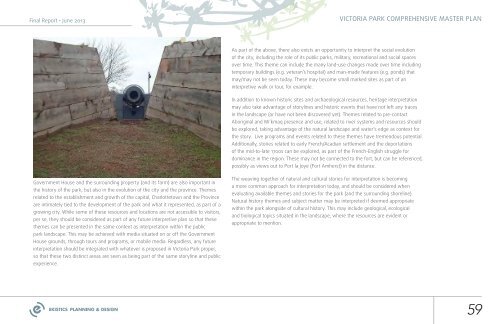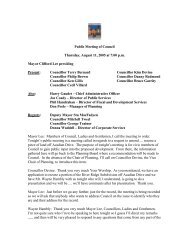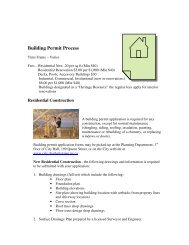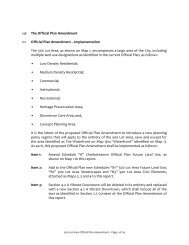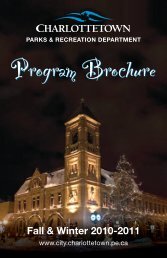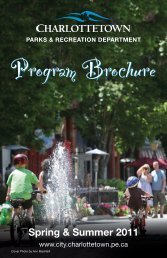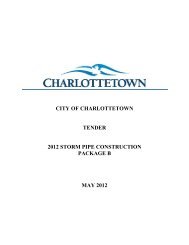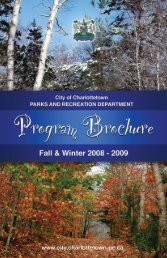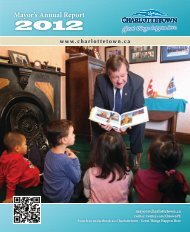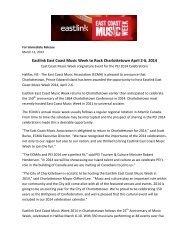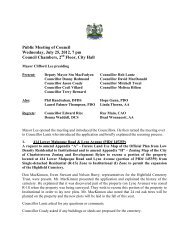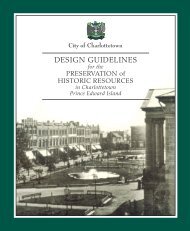Victoria_Park_Re port Final.pdf - City of Charlottetown
Victoria_Park_Re port Final.pdf - City of Charlottetown
Victoria_Park_Re port Final.pdf - City of Charlottetown
You also want an ePaper? Increase the reach of your titles
YUMPU automatically turns print PDFs into web optimized ePapers that Google loves.
<strong>Final</strong> <strong>Re</strong><strong>port</strong> • June 2013<br />
VICTORIA PARK COMPREHENSIVE MASTER PLAN<br />
As part <strong>of</strong> the above, there also exists an op<strong>port</strong>unity to interpret the social evolution<br />
<strong>of</strong> the city, including the role <strong>of</strong> its public parks, military, recreational and social spaces<br />
over time. This theme can include the many land-use changes made over time including<br />
temporary buildings (e.g. veteran’s hospital) and man-made features (e.g. ponds) that<br />
may/may not be seen today. These may become small marked sites as part <strong>of</strong> an<br />
interpretive walk or tour, for example.<br />
In addition to known historic sites and archaeological resources, heritage interpretation<br />
may also take advantage <strong>of</strong> storylines and historic events that have not left any traces<br />
in the landscape (or have not been discovered yet). Themes related to pre-contact<br />
Aboriginal and Mi’kmaq presence and use, related to river systems and resources should<br />
be explored, taking advantage <strong>of</strong> the natural landscape and water’s edge as context for<br />
the story. Live programs and events related to these themes have tremendous potential.<br />
Additionally, stories related to early French/Acadian settlement and the de<strong>port</strong>ations<br />
<strong>of</strong> the mid-to-late 1700s can be explored, as part <strong>of</strong> the French-English struggle for<br />
dominance in the region. These may not be connected to the fort, but can be referenced,<br />
possibly as views out to Port la Joye (Fort Amherst) in the distance.<br />
Government House and the surrounding property (and its farm) are also im<strong>port</strong>ant in<br />
the history <strong>of</strong> the park, but also in the evolution <strong>of</strong> the city and the province. Themes<br />
related to the establishment and growth <strong>of</strong> the capital, <strong>Charlottetown</strong> and the Province<br />
are intimately tied to the development <strong>of</strong> the park and what it represented, as part <strong>of</strong> a<br />
growing city. While some <strong>of</strong> these resources and locations are not accessible to visitors,<br />
per se, they should be considered as part <strong>of</strong> any future interpretive plan so that these<br />
themes can be presented in the same context as interpretation within the public<br />
park landscape. This may be achieved with media situated on or <strong>of</strong>f the Government<br />
House grounds, through tours and programs, or mobile media. <strong>Re</strong>gardless, any future<br />
interpretation should be integrated with whatever is proposed in <strong>Victoria</strong> <strong>Park</strong> proper,<br />
so that these two distinct areas are seen as being part <strong>of</strong> the same storyline and public<br />
experience.<br />
The weaving together <strong>of</strong> natural and cultural stories for interpretation is becoming<br />
a more common approach for interpretation today, and should be considered when<br />
evaluating available themes and stories for the park (and the surrounding shoreline).<br />
Natural history themes and subject matter may be interpreted if deemed appropriate<br />
within the park alongside <strong>of</strong> cultural history. This may include geological, ecological<br />
and biological topics situated in the landscape, where the resources are evident or<br />
appropriate to mention.<br />
59


